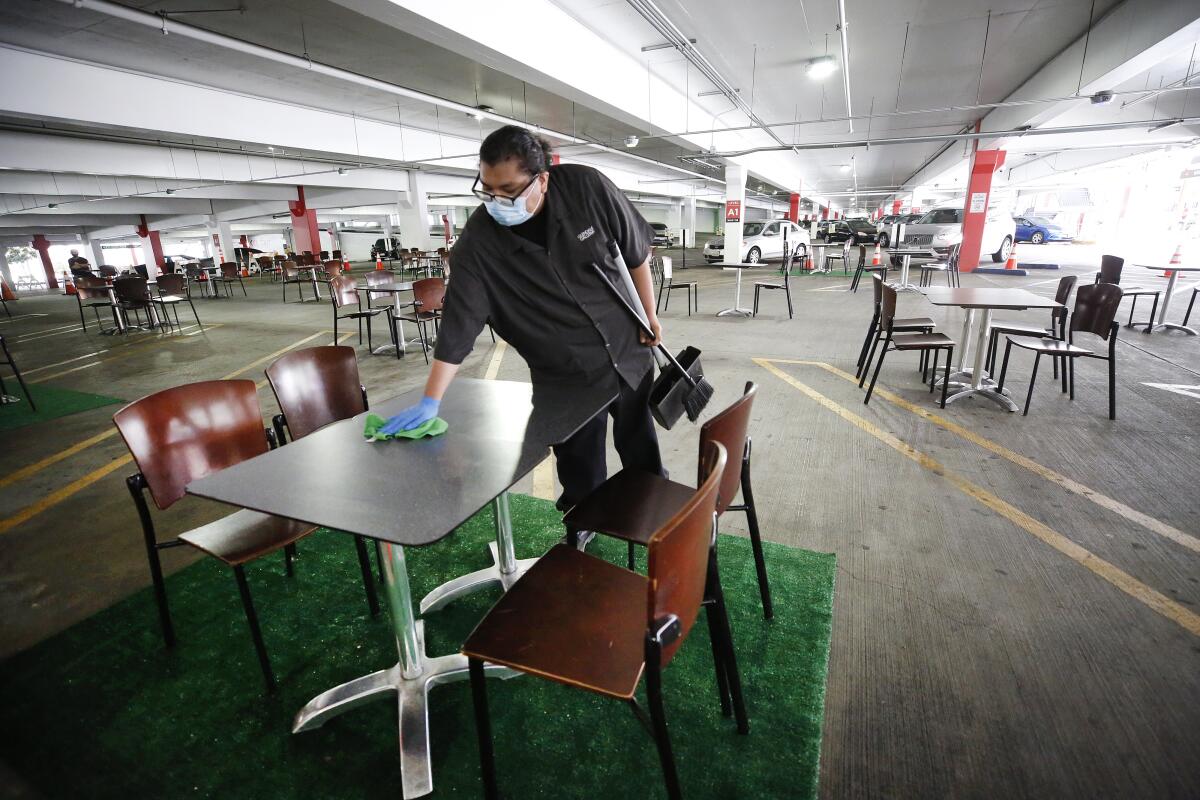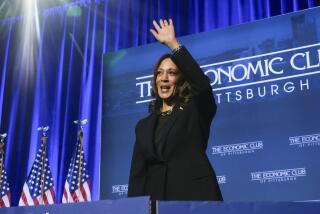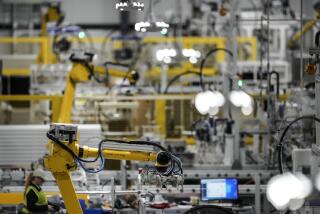Record collapse in GDP points to challenges for economic recovery — and Trump

WASHINGTON — U.S. economic output fell at a stunning 32.9% annual rate in the second quarter — a level not seen since the Great Depression and by far the largest drop since government record-keeping began in 1947, according to data released Thursday.
The sharp contraction, reflected in the government’s report of gross domestic product, came on the heels of a 5% decline in GDP during the first quarter and marked what most economists predict will be the bottom of the coronavirus-induced recession that officially began in February. The new numbers on GDP — the sum of all goods and services produced in the country — include data from the mini-recovery that occurred before the latest surge in the COVID-19 pandemic.
Now with the coronavirus rampaging over large areas of the country, measures of consumer spending, small-business activity and job openings are slowing again, casting a shadow over economic conditions many Americans will face as election day draws near.
A separate report Thursday from the Labor Department showed new unemployment claims rose last week to 1.43 million. It was the second straight week of increase — following about three months of steady declines — and brought the total number of people who have applied for jobless benefits since mid-March to more than 54 million, which is about a third of the American labor force.
Taken together, the new economic reports point to significant hurdles for President Trump in his reelection bid and lend fresh urgency to lawmakers who are wrangling over provisions to provide another round of support to the economy.
The nearly $3 trillion worth of pandemic relief measures approved earlier by Congress have clearly buoyed the economy, but the effect of those initial programs is ebbing.
Many small businesses are running out of loans and grants that kept paychecks going out to at least some workers. State governments are financially distressed. And millions of jobless workers will see their enhanced unemployment benefit checks end this week.
Federal Reserve Chairman Jerome H. Powell said Wednesday that additional fiscal support is “essential” for the recovery. He spoke particularly about the hardship of unemployment, which has fallen disproportionately on minorities, women and low-wage workers in service industries such as hotels, restaurants and entertainment venues.
“Many of those people are going to find it hard [that] they can’t go back to their old job. There won’t be enough jobs for them. So I think those people are going to need support,” he said during a remote news conference. “I can’t say what the exact level should be. It is not our role. But they are going to need support if they are to be able to pay their bills, to continue spending money, to remain in their current rental house or apartment or house if they own it.”
The forecasting firm IHS Markit is predicting the third quarter will grow at a 19.1% annual rate. But as much as that may represent a substantial rebound, analysts said that’s not what many people on the ground will be feeling. The unemployment rate was 11.1% in June and is likely to remain in double digits through the fall. Thus far, the economy has recovered only one-third of approximately 22 million jobs lost since February, and private-sector payrolls could have turned down again in July.
Consumer spending, which accounts for about 70% of U.S. economic activity, fell nearly 35% in the second quarter. Business investments and exports tumbled as well. The only major component of GDP that grew over the quarter was government, thanks to the deficit-financed spending to help businesses and households.
“We fell down a huge hole in March and April, and we were only able to climb partway out,” said Ethan Harris, head of global economics research at Bank of America Merrill Lynch. “The challenge is that we’re now entering a period where you’re kind of stuck at the halfway point with the economy starting to level off again.”
Unless the recovery falls off the rails, which few experts expect, the coronavirus recession could be one of the shortest in history, technically speaking. But the effects will be long-lasting.
The nonpartisan Congressional Budget Office doesn’t see real GDP recovering to its pre-pandemic level until the middle of 2022, and it’ll probably be years after that before the economy returns to full employment.
For Trump, the pandemic has undercut his plan to campaign for reelection on the strength of the economy. Since the pandemic began, he has fallen well behind former Vice President Joe Biden, the presumptive Democratic nominee, in national polls as well as in surveys of voters in some swing states.
In late February before the coronavirus outbreak swept the U.S., Trump and Biden were tied in the polls in Wisconsin, a state Trump won by a very narrow margin in 2016.
But by mid-June, Trump was running 8 points behind Biden in Wisconsin, with substantially more independent voters expressing disapproval of Trump’s handling of the COVID-19 pandemic than in the early days of the health crisis in March, according to the Marquette Law School Poll.
The new fiscal relief package hammered out by the White House and Senate Republicans in recent days is aimed squarely at trying to turn the reversal into short-term economic and political gains.
They’ve proposed a $1-trillion package that includes slashing the $600 weekly federal add-on to state unemployment benefits; giving another round of $1,200 in cash to tens of millions of Americans; and offering billions of dollars in new aid to schools that reopen promptly this fall, as Trump has urged but COVID-19 experts have warned against.
But the plan isn’t nearly big enough or well-targeted to provide a strong boost, most economists said, and it faces stiff pushback from House Democrats, who earlier passed a $3-trillion proposal that includes allocating $1 trillion for state and local governments and maintains the $600-a-week unemployment supplement through January.
The Republican provisions, coupled with the likelihood that the third-quarter GDP report just before election day will show a big improvement, could help Trump portray the U.S. as back on the road to normalcy, even if the pandemic keeps rolling and illnesses and deaths are continuing to mount.
Cutting the $600 jobless benefit payments, or abolishing them entirely as some Republican senators favor, would pressure workers to return to jobs even if that increased their risk of contracting the coronavirus.
That in turn could lower the nation’s unemployment rate, which Trump would cite as evidence that the COVID-19 crisis was fading.
Similarly, if large numbers of schools reopen in traditional fashion instead of relying on distance learning and part-time classroom sessions, swing voters might be more open to campaign arguments that things were getting back to normal.
Tim Murtaugh, communications director for the Trump campaign, said Thursday’s GDP report isn’t an indicator of where things are headed.
“The media is also grabbing on to the annualized number which supposes that the economic conditions will remain the same for an entire year, which it undoubtedly will not,” he said. “The president’s policies already have the economy rebounding as the jobs reports from May and June show that an incredible 7.5 million jobs were created as lockdowns ended and businesses began reopening.”
Mark Zandi, chief economist at Moody’s Analytics, agreed that the second-quarter data are “all in the rearview now.” Nonetheless, he noted that the report “gives us a sense of how deep the hole the economy fell into during the pandemic, and how hard it’s going to be to completely climb out.”
During the worst of the Great Recession, GDP shrank at an annualized 8.4% pace in the final quarter of 2008. And before that, the single largest annualized quarterly decline recorded by the Commerce Department was 10% in early 1958.
GDP numbers could very well bounce back in the third quarter, but it may be too late. Studies have shown that not only do voters tend to focus on the last year of a president’s performance — rather than the whole four years — but their views on the economy are baked into their decision by the summer of an election year.
“My sense is people’s perceptions of a recovering economy aren’t going to be especially good,” said Marc Hetherington, a political scientist at the University of North Carolina at Chapel Hill, who found that a recovering economy in the waning months of George H.W. Bush’s reelection bid in 1992 wasn’t enough.
“It usually takes a while for people to perceive that kind of improvement. You don’t start to feel it in your real life until after the uptick has taken place and is being sustained for a while,” Hetherington said.
He cautioned that this pandemic-driven economy may be an outlier given the sudden and extraordinary set of events. And Trump may be able to deliver strong GDP numbers in the third quarter, as the president has predicted.
Still, Hetherington said: “If those numbers don’t square with people’s perceptions and their experience with the economy, they’re not going to make a hill of beans’ worth of difference.”
More to Read
Get the L.A. Times Politics newsletter
Deeply reported insights into legislation, politics and policy from Sacramento, Washington and beyond. In your inbox three times per week.
You may occasionally receive promotional content from the Los Angeles Times.











